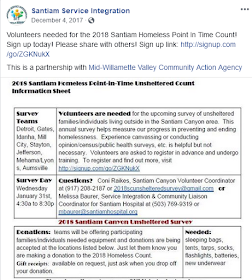By Sarah Owens and Michael Livingston
 |
| OHCS's 2019 PITC data "tableau" |
Last January, "everybody" thought the count had netted a record number of unsheltered homeless -- over 800 -- in Marion and Polk counties. See Whitworth, W. "Homeless PIT Count shows 20 percent increase in Marion, Polk Counties, with big caveat." (15 February 2019, Statesman Journal.)
Unfortunately, what was reported to HUD was that Marion and Polk had counted less than 600 unsheltered individuals. The problem? The 28-county Rural Oregon Continuum of Care or "ROCC."
As has long been known, ROCC is an organizational disaster that cripples effective homeless services delivery at the local and regional levels, and the weakest of its weak links is its data. As was reported to the Housing Stability Council this month,
 |
| 12/6/19 OHCS Memo to Housing Stability Council at 95 |
This year, after ROCC finished mangling Marion and Polk's 2019 PITC data, it reported to OHCS and HUD that the total number of homeless individuals in Marion and Polk counties was not 1,462 (rough count), but 1,095 (official count). That is to say, instead of the 20% increase over 2018 reported by the Statesman Journal, the *official* 2019 numbers reflect a decrease. (The total count in 2018 was 1,218 but OHCS and HUD don't recognize even-year counts. The last recognized unsheltered count was in 2017 and totaled 1,151 individuals. See OHCS's 2015-2017 PITC data "tableau.") To see OHCS's analysis of the official statewide data, see here.
 |
| Statesman Journal 1/30/19 |
 |
| Call for volunteers for the 2018 unsheltered PITC |
There's no real problem with counting the "sheltered" homeless every year. That data is fairly easy to pull together, and we should do it as long as HUD requires it. But, in even years, it makes less and less sense to conduct an unsheltered count. Especially when HUD doesn't require it, and when there is more reliable data available elsewhere. According to Jimmy Jones, MWVCAA Executive Director, we know from data collected through ServicePoint, Oregon's Homeless Management Information System, that Salem alone has about 1,800 homeless individuals inside the Urban Growth Boundary, 1,400 of whom are unsheltered (400 in cars, 1,000 outside). See "Camping Ban for Christmas."
As we have a very good idea how many unsheltered there are in Salem, there's no justification for sending people in even years into the Canyon or the woods outside Woodburn or Dallas, looking for camps and upsetting people who just want to be left alone. There's no point in collecting "data" that won't be used.
The 2020 PITC is especially going to be an exercise in futility. Law enforcement have dispersed (and dispersed, and dispersed)
the nearly 200 people who for years lived in the area around Wallace
Marine Park. Last year, they were counted, but they won't be this year.
In 2020, and in all even years, volunteers should simply be asked to help out at the Salem Community Homeless Connect or the Santiam Outreach Community Center or one of the warming centers in the Polk County or City of Salem warming networks. If, as Jones has said on multiple occasions, community resources for the homeless are well and truly spread "like butter over warm toast", the answer cannot continue to be, "We've always done it this way."
1/5/21 update: as of this writing, Marion and Polk county's re-created CoC (OR-504), called the Mid-Willamette Homeless Alliance, has yet to publish the 2020 PITC data, probably related to significant unforced errors in its collection, both sheltered and unsheltered.
1/18/21 update: find our report based on data provided by ROCC staff here.
No comments:
Post a Comment